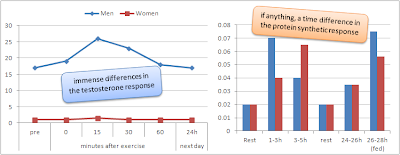 |
| Image 1: Is it not testosterone that makes the difference? |
Women are different, but it's not about protein synthesis
In the recently conducted trial Daniel W.D. West, who has also been the lead author of the "Never Sip Your Whey" study, I covered back in November 2011, undertook another attempt to identify the intricate endo- and paracrine mechanisms of skeletal muscle hypertrophy and its sex-specific variability. To this ends, West et al. recruited 5 male and 5 female subjects, who "who were habitually engaging in two to five sessions of physical activity per week including", yet did not train legs more than twice a week.
 |
| Image 1: In this case, testosterone took a backseat, as well. With synthol, protein synthesis is yet unnecessary anyway. |
- 5 sets of 10 repetitions of leg press at ~90% of their individual 10RM, and
- 3 super-sets of 12 repetitions of leg extension/leg curl at ~90% of 12 RM
 |
| Figure 1: Serum testosterone levels (in nM) and myofibrillar fractional protein synthesis rate (in %/h) before and after the resistance workout, as well as on the morning and at noon of the 2nd day (data adapted from West. 2012) |
Akt Ser473 phosphorylation increased at 1h ( P < 0.001, main effect for time) and to a greater extent in men (sex × time interaction, P = 0.018). Phosphorylation of mTOR Ser2448 was increased at 1, 3 and 5 h (P < 0.001; Figure 4B); there was a main effect for sex (men > women, P = 0.003). Phosphorylation of mTOR Ser2448 was elevated similarly between sexes after next-day protein feeding, approximately 26 h after the exercise bout (sex × time interaction, P = 0.49; main effect for time, 28 > 26 h, P = 0.006). Phosphorylation of p70S6K1 Thr389 increased at 1, 3 and 5 h (all P < 0.001; sex × tim e interaction, P = 0.13) and there was a significant interaction with next-day feeding (28 > 26 h in women only, sex × time interaction, P = 0.016; data not shown). Androgen receptor content was greater overall in men (P = 0.049) but there was no significant interaction ( P = 0.47).The greater increase in mTOR and Akt (both hitherto regarded as the "gas pedals" of the skeletal muscle protein synthetic machinery) are not only less pronounced, than one would expect if there was a direct interaction with testosterone levels, they also lack real world significance. After all, the area under the myofibrillar protein synthesis curve (a measure for the total protein synthetic response to exercise) was identical in the 1-5h period right after the exercise and - although West et al. did not include the respective data in their article - I would suspect that the data from the subsequent day (cf. figure 1, right) would even suggest that it must have been slightly greater in the female participants.
Testosterone useless and mTOR and Akt unreliable indicators at best?
Now, which conclusions shall be drawn from these results? Is testosterone useless? Does it not contribute to the overall greater muscle mass in men compared to women? It stands to reason that this conclusion would be about as flawed as the notion that testosterone alone would suffice to build muscle. Rather than its "inefficiency" in building muscle, this study only shows that its importance in relation to the exercise-induced increase in protein synthesis is probably way overrated.
A similar point could be made for mTOR and Akt, as well, though. Or as West et al. put it in their discussion of the results and the respective implications for future studies:
In light of this disconnect, it is worth recognizing that the phosphorylation of signalling proteins is a temporal snapshot of the propagated signal for translation initiation. It is also unclear if there is a minimum threshold signal required to initiate and completely activate or ‘turn on’ translation. If there is such a threshold then it seems plausible that greater phosphorylation above such a threshold would be unlikely to further amplify the signal/lead to increased rates of translation.For a physicist or anybody who knows a thing about "energy levels" the existence of "threshold" levels in processes taking place at a molecular level should not come as a surprise.
I suspect, we are still missing the boat with our focus on protein synthesis alone
Another question, I have been hinting at in many of my previous blogposts on the insightful studies from Stuart Phillips lab at the McMaster University, is yet whether or not the acute increase in protein synthesis (alone) is actually an acceptable predictor of skeletal muscle hypertrophy, a process which, as I have explained in detail in the Intermittent Thoughts on Building Muscle is only partly mediated by the simple accrual of amino acid chains (=proteins) within existing myofibrillar domains.
 |
| Figure 2: Graphical illustration of the processes and their respective triggers which contribute to the exercise induced increase in skeletal muscle mass (click here for detailed elaborations). |










0 comments:
Post a Comment